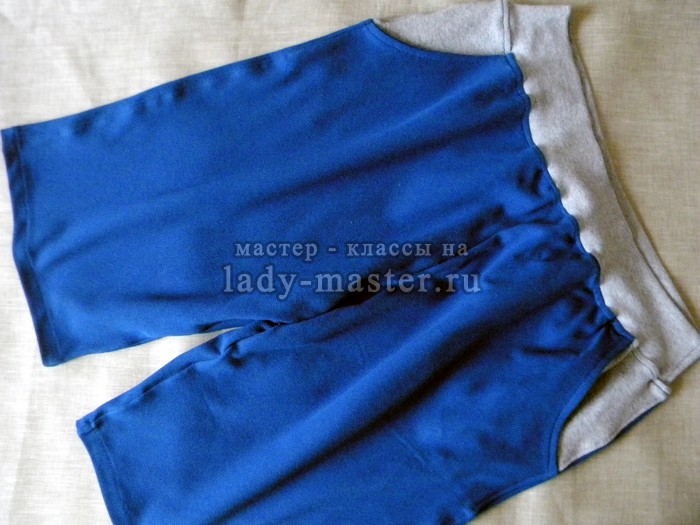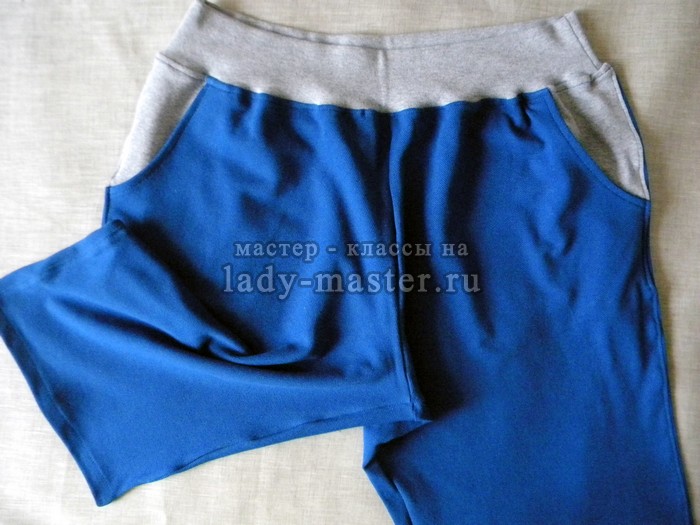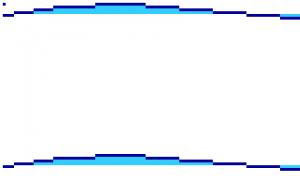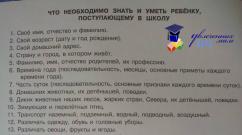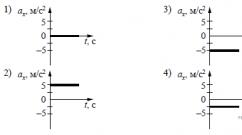Men's shorts pattern construction. Pattern of men's shorts: taking measurements, building a pattern, tips for novice seamstresses and experienced craftsmen in video tutorials.
The pattern of men's shorts with an elastic band appeared one of the first on the site, which is clear from its serial number. The pattern was built, as already indicated by me, under the cheerful jersey in mice.
Actually, this jersey made me build a separate pattern, and not dance from the existing one. The waistband from which the shorts were sewn is a rather flimsy material for a man, but due to the increased width of the shorts, it turns out to be quite reliable.
The pattern should be suitable for sewing the simplest men's underpants"Family members", if, of course, I remember them correctly. It is better to use knitwear for panties, but classic satin will do.
Cutting men's shorts with elastic
The pattern of men's shorts is built without seam allowances, we will add them ourselves. The width of all sewing allowances on normal sewing machine equal to the width of the foot, for overlock - the width of the stitch. We cut the pockets with 1 cm allowances, at the top - 2 cm.
The pattern of men's shorts with an elastic band already contains a one-piece belt and hem, nothing needs to be added, except for processing allowances.
We will cut two front and two back halves, the pocket can be one or two. I sewed one with a zipper.
Sewing men's shorts with elastic
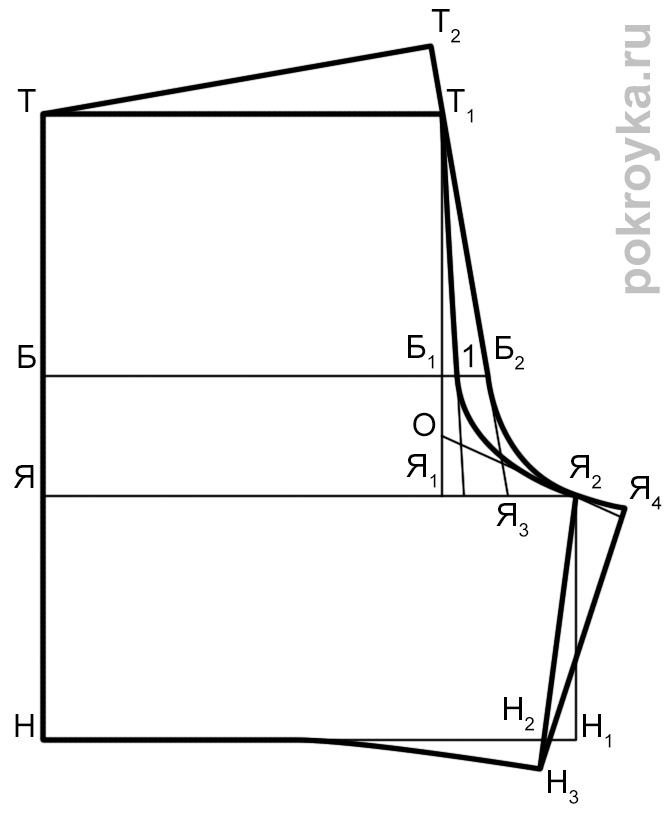 Like other waist patterns of this kind, this one is extremely simple.
Like other waist patterns of this kind, this one is extremely simple.
If we make a pocket, then we start with it. Iron the entrance to the pocket twice and secure it with parallel finishing stitches. Iron the remaining sections of the pocket on the seamy side by 1 cm.We transfer the location lines from the pattern
In summer, your companion cannot do without men's shorts! They are especially convenient on vacation - in shorts you can go to the beach, to a cafe, or to a youth disco! And even if you have already bought shorts for relaxation, sew another one according to our pattern - firstly, tailored to individual measurements - a real exclusive, and secondly, such shorts will fit perfectly!
Fig. 1. Pattern of men's shorts
Before you start building a pattern for men's shorts, you need to take the following measurements:
Waist half-girth - 44 cm
Semi-girth of the thighs (on the buttocks) - 50 cm
Shorts length - 56 cm
IMPORTANT! Do not shorten the length of the shorts on the pattern, this construction is only for long shorts.
Modeling the front half of men's shorts
Draw horizontal and vertical lines from point A to the right and down.
Length of the product. From point A, lay down the length of men's shorts according to the measure - point H1: AH1 = 58 cm (length of the shorts by measure +2 cm).
Step line. From point A vertically downward, postpone 1/2 of the half-girth of the hips by measurement plus 3 cm - point B:
AB = 50/2 + 3 = 28 cm.
From point B draw a horizontal line BG1 - the step line for men's shorts.
From point H1 draw a line parallel to the AT line.
Front waist width. From point A along the line to the right, set aside ½ half-girth of the hips by measuring plus 3 cm - point T: AT = 50/2 + 3 = 28 cm.
Draw a perpendicular down from point T; at the intersection with the step line we put point B1, and at the intersection with the length line - point H4. Н4Н2 is equal to 1 cm.
We connect points H and H2 with a slightly concave line.
Bottom width of the front half. H2H3 = 5 cm.
Connect points A and T1 with a straight line.
Front half step width. From point B1 along the step line, set aside to the right 1/10 of the half-girth of the buttocks according to the measure plus 0.5 cm and set the point D: B1G = 50/10 + 0.5 = 5.5 cm.
Connect points B2 and G with a concave line, points G and H3 - connect with a concave line.
Additionally, build a one-piece zip-up valance 4 cm wide and 19 cm long (zipper length 18 cm).
Men's shorts front half pattern - green outline.
Building the back half.
Back seam of men's shorts. T1T2 = 2.5 cm.
Connect points Г, Т2 with a straight line and continue it upwards from point Т2.
From point T2 we put 4 cm upwards and set point A1: T2A1 = 4 cm.
Connect points A, A1 with a straight line.
Step width of the back half of men's shorts: ГГ1 = 4 cm.
The width of the bottom of the back half of men's shorts: From point H4, set aside 2 cm to the left.
Connect points H and 2 (lower right point) with a slightly concave line. Connect points A1 and G1 with a line along the pattern, as shown in the pattern of men's panties (red line), extend it by 1 cm - point G2. We connect points Г2 and 2 (lower) with a curved line.
The pattern of the front half of the men's shorts is a green outline, the pattern of the back half of the men's shorts is a red outline.
Men's shorts are cut out on a pattern on the fabric with a seam on the side. You can cut the shorts unfolded without a side seam if the width of the fabric allows.
Men's shorts - cut
Cut out from the main fabric:
Front half of shorts - 2 pieces
Back half of shorts - 2 pieces
When cutting the shorts on the fabric, make an allowance for hemming the bottom of the shorts 3 cm, at the top - 6 cm, for all other seams - 1 cm.
An elastic band 3 cm wide is measured along the back of the waist with a slight tension (inserted into the finished belt along the back and straightened along the waist (on the sides)).
Punch the blocks at the front on the belt, sew a hook at the front. Additionally, insert a string into the belt.
How to sew men's shorts
Stitch side seams and inner crotch seams. ... Stitch middle seam from middle of back to zipper hem. Sew in. Punch 2 blocks in front to thread the strings. Tuck and topstitch allowance on the top of the shorts.
Measure and cut off the elastic for the back belt. Using a pin, insert the elastic into the belt, restitch along the side seams. Stitch the belt in front with two vertical lines. Insert the lace. Tuck up the hem of the shorts and sew. Your shorts are ready!
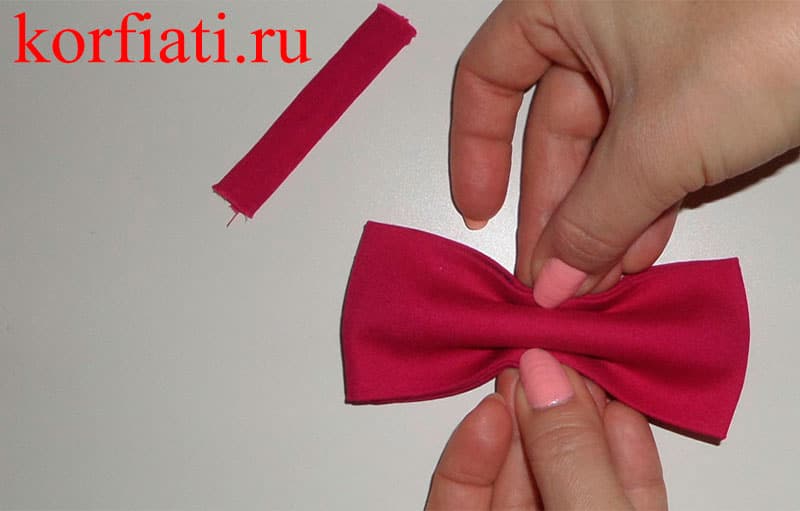
Every man has at least one pair of shorts in his wardrobe. And this is not surprising, because shorts are a very comfortable and practical thing, especially in the warm season. V modern world men's shorts have different purposes: beach, leisure and tourism, sports, denim and everyday urban.
In today's article, we will consider the construction patterns of sports men's shorts with functional pockets and a belt with elastic tape and a drawcord, which ensures a good fit of the shorts on the figure.
As an example, let's use the following figure measurements:
Basic jogging shorts pattern
1. Draw a vertical line with the top at point T, from which the height of the seat is laid down: TY = measurement BC = 25 cm, where
BC = DSB - DN = 106 cm - 81 cm = 25 cm.
2. Shorts length: YAN = 16 cm.

3. Position of the hip line: YB = 1/10 SB + 3 cm = 1/10 50 cm + 3 cm = 8 cm.
Draw horizontals through T, B, Z, H to the right.
4. The width of the front of men's shorts: YY 1 = 1/2 SB + 1 cm = 1/2 50 cm + 1 cm = 26 cm.
Draw up a vertical from Ya 1, at the intersection with the horizontals we get B 1, T 1.
5. Step width: I 1 I 2 = 1/3 of the segment IY 1 = 1/3 26 cm = 8.7 cm.
6. From Z 2 down, draw a vertical to the bottom line. We get H 1.
7. From H 1 set aside 2 cm to the left. H 1 H 2 = 2 cm.
8. Through I 2, H 2 draw a step cut and extend it 2 cm down. H 2 H 3 = 2 cm.
9. Draw a line for the bottom of the shorts in accordance with the picture.
10. To build the midline of the front of the shorts from B 1, set aside 1 cm to the right.
From Z 1 up to postpone 1/2 of the segment Z 1 I 2, we get a point O, which is connected by a straight line with Z 2.
Draw out the middle line through T 1, 1, Z 2.
11. To determine the step width of the back of the men's shorts, extend the auxiliary inclined line (segment OZ 2) by 3.5 cm outward and draw a step cut of the back of the shorts from this point to H 3.
12. Measure the length of the step cut of the front of the shorts and transfer to the back from bottom to top, we get I 4. I 2 H 3 = H 3 I 4
13. Divide the segment I 1 I 2 in half, we get I 3, which is connected by a straight line with T 1 and extend it upwards by 4-5 cm. T 1 T 2 = 4-5 cm.
On the line of the hips we get point B 2.
Draw out the middle line through T 2, T 1, B 2, Z 2, Z 4.
Sports shorts with stitched waistband
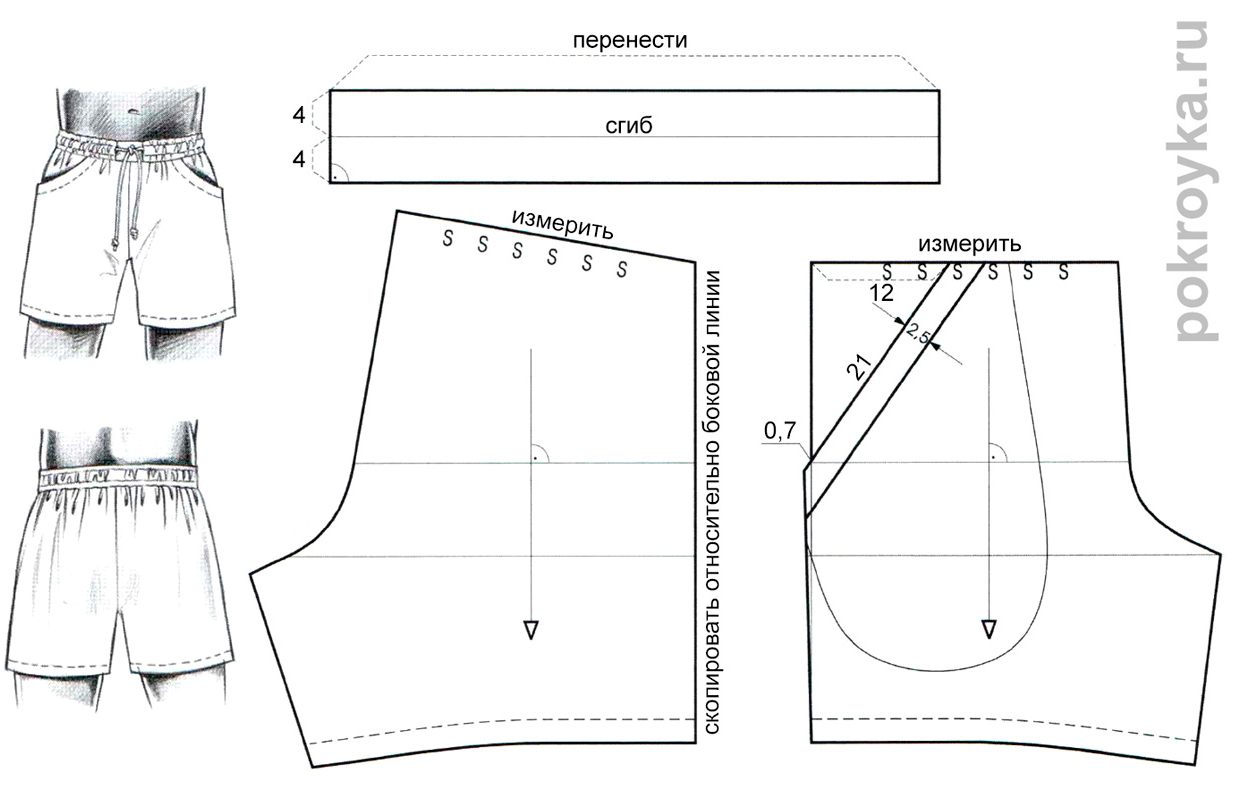
1. Duplicate the front and back of the basic jogging shorts pattern.
2. Draw the lines of the 21 cm long slant pocket as shown.
3. Draw a piece of pocket 2.5 cm wide.
4. Extend the line of entry into the pocket from the side cut by 0.7 cm outward and draw a new side cut of the front of the shorts. As a result, the entrance to the pocket will gain additional length and will not adhere to the product.
5. Draw pocket lining.
6. Measure the length of the upper cut of the shorts and draw a belt 2x4 cm wide. The length of the belt with elastic tape and cord should be 1/2 OTP.
Sports shorts with one-piece waistband
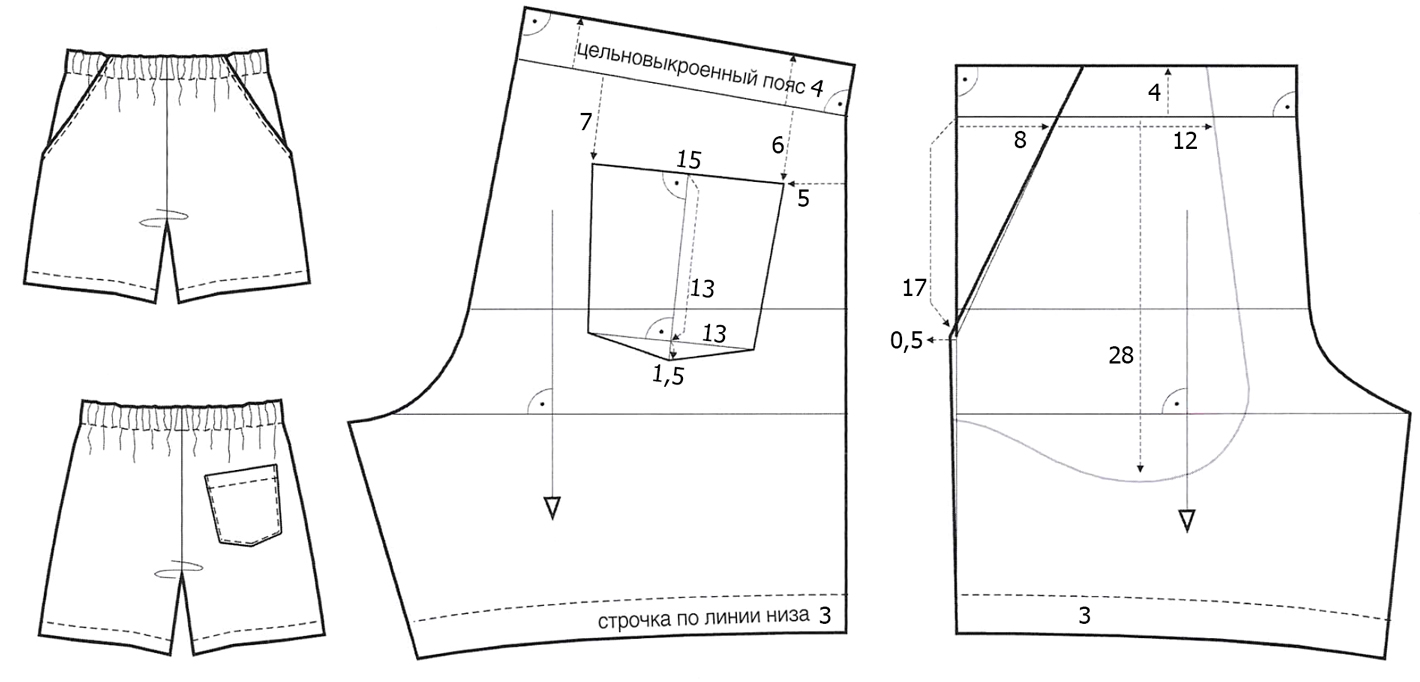
1. Copy the cut details of the front and back parts of the shorts from the drawing of the base base, check the length of the cuts and cuts at the mating points and align if necessary.
2. Draw a one-piece belt 4 cm wide parallel to the waist.
3. Draw the entrance to the pocket in accordance with the drawing, along the lateral line, expand the front of the shorts by 0.5 cm (lengthening the line of the entrance to the pocket) and draw a new line of entry into the pocket and the side line of the front of the shorts.
4. Draw the outlines of the pocket lining. Draw patch pocket on back of shorts.
Good day, dear site visitors!
Pattern of men's shorts
Personally, I decided to act quickly, so I didn't dare to build a pattern, because it takes me a whole evening. For a long time already for my children and my husband I cut out such simple things as pants, shorts by the method of outlining ready-made things.
I chose a thin and light jacket fabric, the shorts turned out to be almost weightless, you can even swim in these, they will dry out in a few minutes!
This time I am making shorts without side pockets, I will only make a patch pocket on the back with Velcro.
So, we take the shorts of the husband (son, grandson, etc. - to whom you are going to sew them) and simply circle the front half first, then the back one. Do not forget to add 1 cm seam allowances and hem and elastic bands of 3-4 cm. We will need 2 parts for each part of the pattern. I draw directly onto the fabric, but if in doubt, it is better to first remove the pattern on paper. Subsequently, you can make adjustments and this pattern can serve you more than once.
We cut out the pocket in the required shape. On top we make a hem allowance of 2 cm, and on the other sides by 0.7-1 cm.

Pattern details
Sewing men's summer shorts
When all the parts are ready, it is necessary to process the sections so that the fabric does not crumble. This can be done with a regular zigzag stitch, preferably with a special overlock foot, or with a help that immediately cuts off excess fabric. I have chosen one of the stitches, which is designed for overcasting the edge of the product. In my opinion, it looks neat enough.
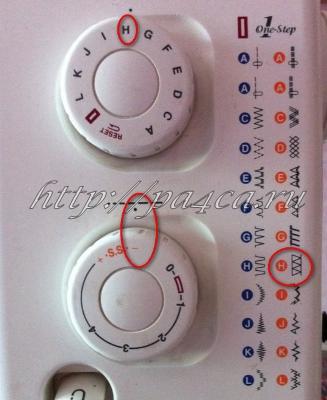
Stitch selection
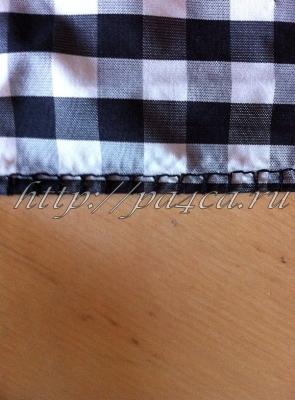
Finished edge
Now we iron the allowances for the hem inward on the pocket.
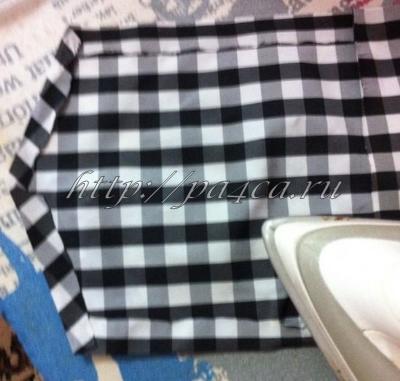
Sew the pocket at the top and sew on left side one of the parts of the Velcro.
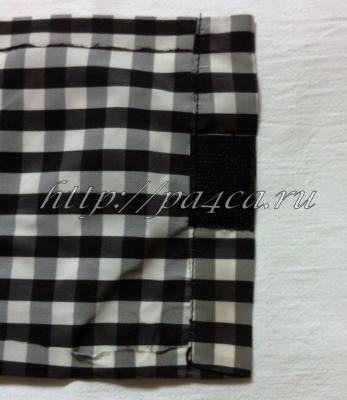
Top of pocket sewn and Velcro sewn on
On the back half of the shorts, we sew the second part of the Velcro in the place where you plan to sew the pocket, so that the Velcro will match and subsequently the pocket will be fastened.
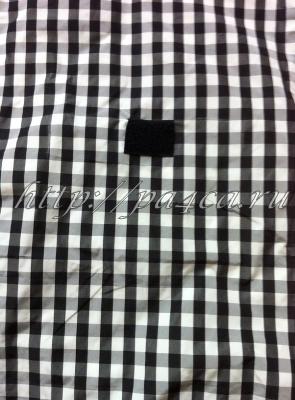
Velcro on the back half of the shorts
Sew the pocket to the back half of the shorts.
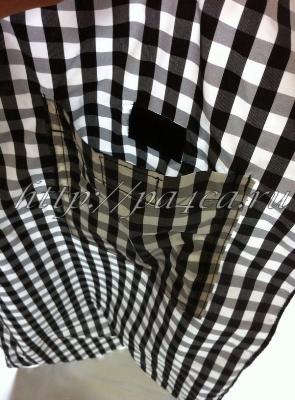
Even if you are an aspiring seamstress, you can make simple clothes for your family. For example, here are such men's knitted shorts in which you can walk around the house and put things in order summer cottage! For sewing such shorts, you can take any thin (summer) knitwear, but lacoste is best. This is a "perforated" knitted fabric, from which polo shirts are most often sewn. Lacoste is completely natural and very pleasant to work with: it will not stretch and deform like a cooler or other thin jersey. So for beginners - exactly what you need!
How to sew beginner shorts?
Materials and tools:
- Lacoste fabric - 0.5 m,
- Summer ribana with elastane (elastic 1 on 1) - small cuts for the belt and burlap pockets,
- Tailor's pins,
- Scissors,
- Sewing machine,
- Threads to match the fabric.
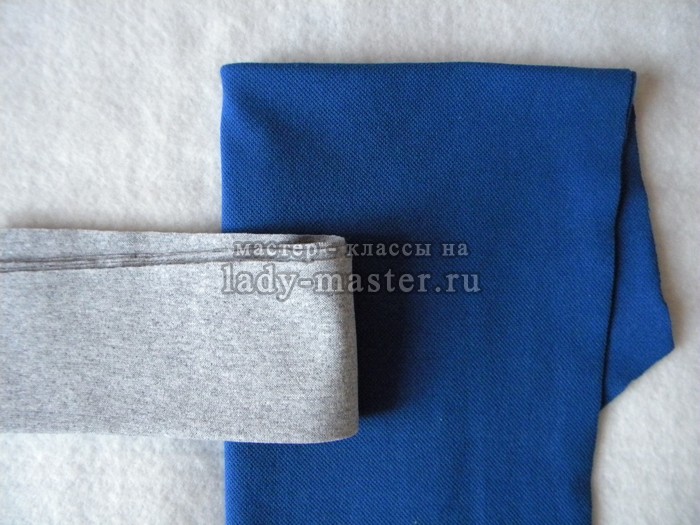
The shorts pattern is taken from the Ottobre children's fashion magazine (№1 / 2015) You can download the pattern. This is model # 38 (jersey pants that we turned into shorts), designed for heights from 134 cm to 170 cm. The pattern for heights 170 cm is just right for a full man's size 50. So, children's magazines are quite a profitable purchase, because you can sew adult clothes on them!
Manufacturing:
1. Cut out the necessary parts from the fabric. In Ottobre magazine, the pants are suggested to be sewn from pieces of fabric (the legs are divided lengthwise), but if you do not have such a need, make one-cut legs. As a result, you should have 2 front leg pieces, 2 back pieces, 2 burlap front pockets, 2 front pocket trim pieces and 2 wide belt pieces. It is better to cut out the burlap pockets and the belt from ribana, but the basic details of the shorts and the facing of the pockets are from lacoste.
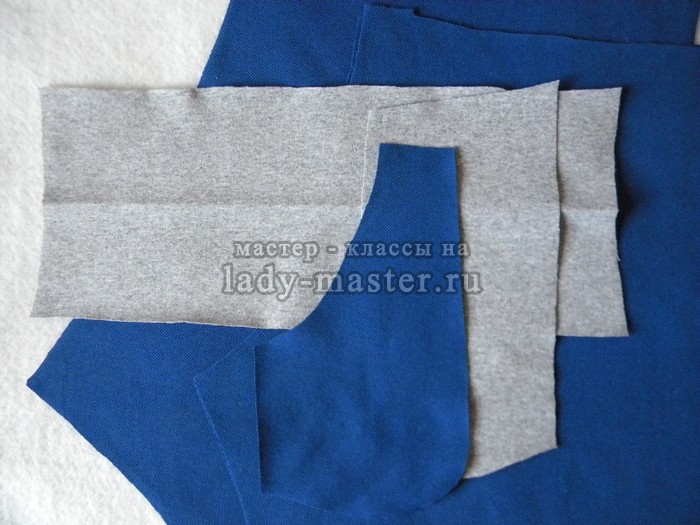
2. First of all, heat up the iron and iron all parts to make sewing easier. Bend both parts of the belt in half and iron.
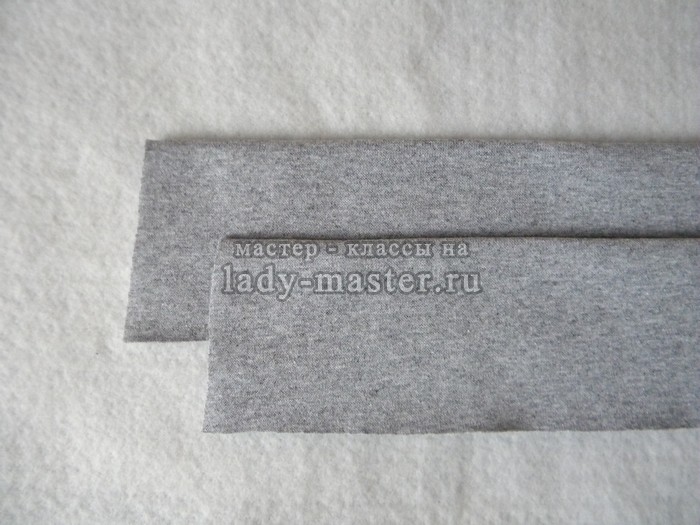
3. Fold the belt details face side inside and pin the side edges on both sides with pins. Connect the burlap pockets to the front leg pieces: do it along the cutout of the pocket, also folding the fabrics face to face.
![]()
4. Sew the waistband on both sides using a serrated stitch (great for knits and prevents the fabric from warping while sewing), then fold the waistband over the ironed fold. Sew the cutouts of the pockets with the same seam.
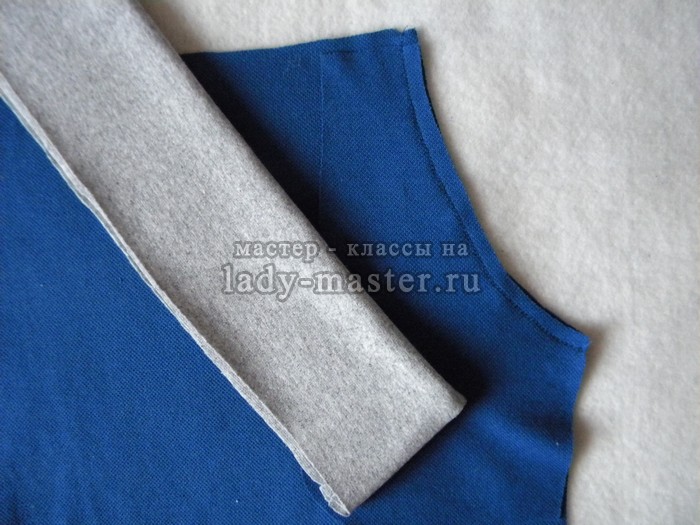
5.From the seamy side (from the one where you sewed the folds of the pockets), use scissors along the seam and make transverse cuts on the allowances at a distance of 5-7 mm from each other. Thanks to this technique, the side of the pocket will look nice and neat, it will not bulge.
![]()
6. Now you can turn the pockets inside out to the front side and, turning the burlap under the main part of the shorts, sew the entrance to the pocket with the usual straight seam, stepping back from the edge of 5 mm.
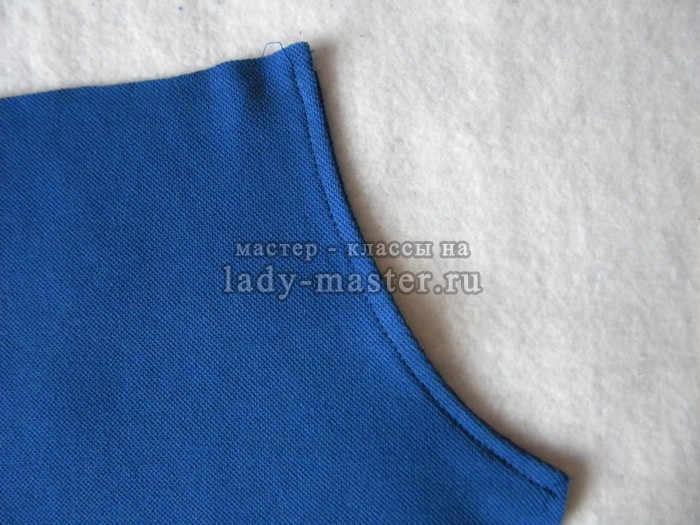
7. Flip the front of the shorts so that it lies seamy side up. On top of the folded burlap pocket, attach the second ribana pocket detail - the pocket facing. Fold the details of the pocket so that they are face to face. Pin off the edges of the pocket pieces.
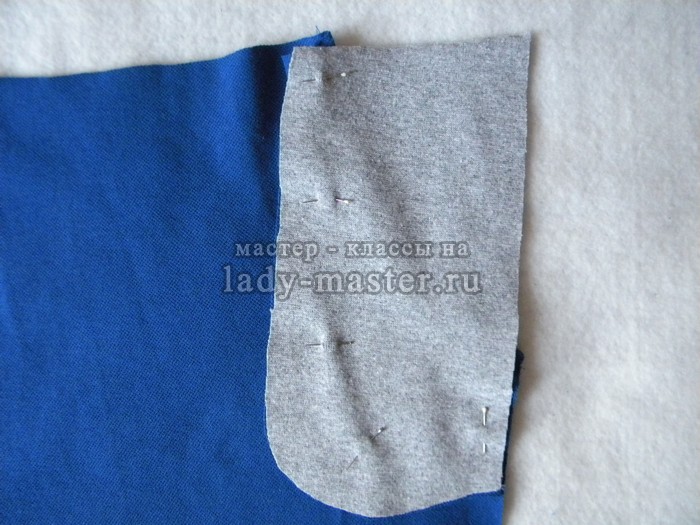
8. Sew the edges of the pocket with two parallel seams (for security and for extra overcasting). Do the same for the second front pocket.
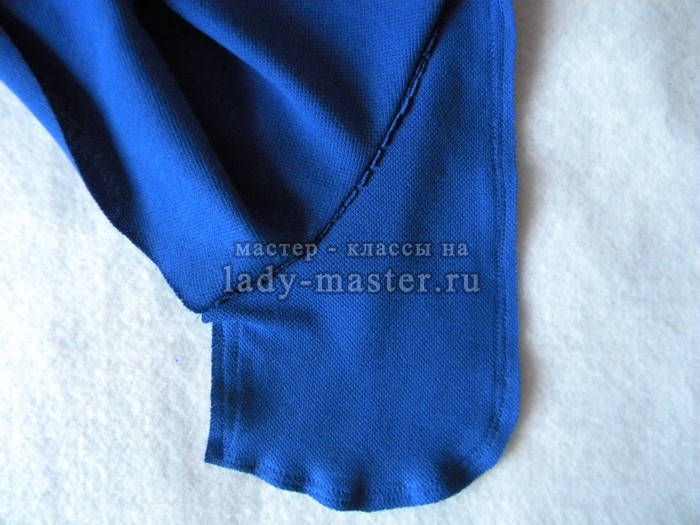
9. All the details of the shorts are already ready, so all that remains is to connect them. Fold the two front halves and the two back halves of the shorts in pairs, face to face, and sew them along the curved seams. Then sew the side seams (connect the front of the shorts to the back) and topstitch them, bending the seam allowances towards the front.
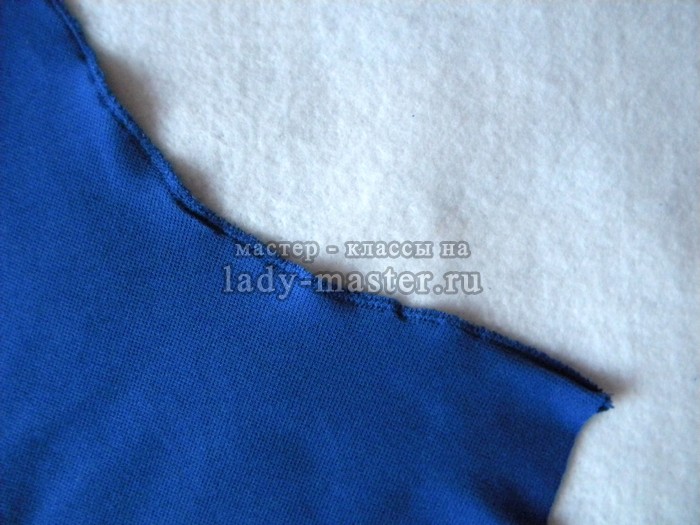
10. Fold the ribana belt with the fold down and attach it with a cut to the cut of the top of the shorts. The belt is a little narrower than the top of the shorts, so you will need to stretch it a little and pin it to the top. Then stitch the waistband to the top of the shorts with a knit stitch.
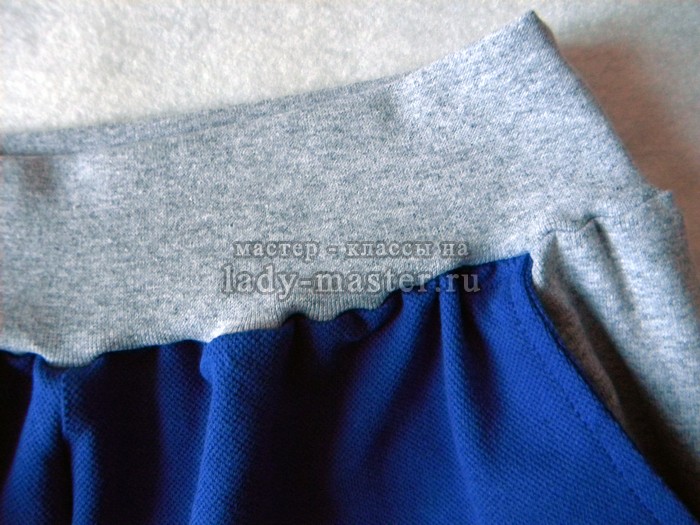
11. Fold down the allowances left over from sewing the belt to the shorts (towards the main part of the shorts) and stitch along front side, stepping back 5 mm from the previous seam. Thanks to the straightening, the product will look neater.
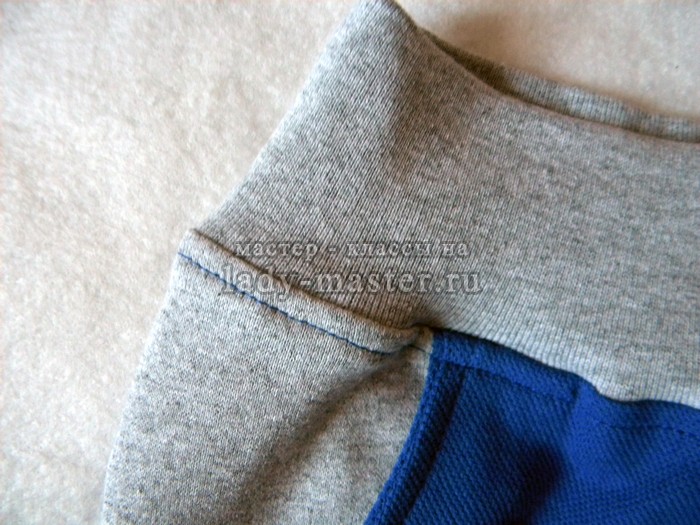
12. Now pin the crotch seam (from the bottom of the left leg through the center to the bottom of the right leg) and sew. Tuck the bottom edge of both legs twice and sew with a straight seam parallel to the edge.
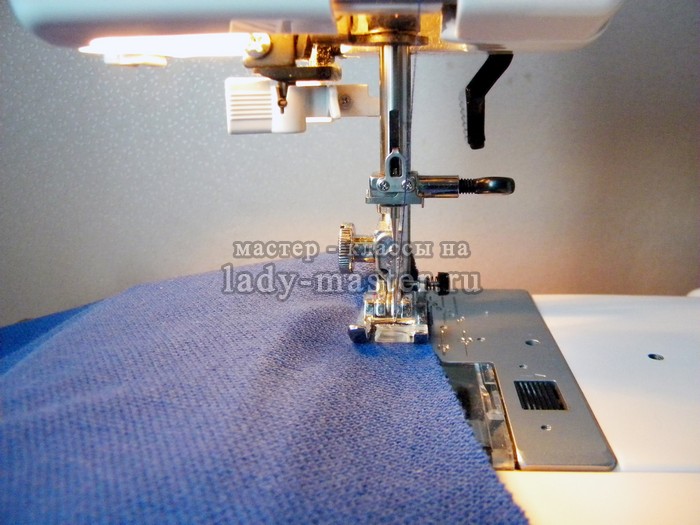
Men's jersey shorts are ready! Ribana with elastane holds its shape quite well, but for reliability, you can also slip a wide elastic band or drawstring into the belt. It will turn out to be both practical and beautiful!
